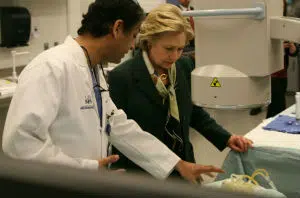The Jacobs Institute, a top-flight research institution specializing in vascular disease, is partnering with Stratasys to create a new Center of Excellence (COE) with the goal of helping physicians and researchers advance the use of 3D printing for a wide range of medical applications.
The Jacobs Institute is located in Buffalo, New York, and is part of the Buffalo-Niagara Medical Campus. On site is a Stratasys Objet500 Connex3 3D Printer, used to both prototype new kinds of medical devices and make patient-specific models, as well as enriching clinical education and training. The COE will also serve as a resource for hospitals, clinics, labs and research facilities that are considering adding or accelerating the use of 3D printing technology.
Sign up for the Stratasys Medical Innovation Series and receive updates on the latest advances in medical 3D printing applications.
Better Together: Paving the Way for Future Medical Advances

A 3D printed model of a proposed new treatment for brain aneurysm, developed at the Jacobs Institute and created with a Stratasys PolyJet 3D Printer.
“By partnering with Stratasys, the Jacobs Institute is bringing the leader in 3D printing to Buffalo to work closely with the JI and its partners, Kaleida Health and the University at Buffalo, to accelerate the development of new medical technologies, “ said Bill Maggio, CEO of the Jacobs Institute. “Working together, the respective institutions will leverage their strengths to make an impact far greater than they could make individually.”
“By partnering with Stratasys, the Jacobs Institute is bringing the leader in 3D printing to Buffalo to work closely with the JI and its partners, Kaleida Health and the University at Buffalo, to accelerate the development of new medical technologies, “ said Bill Maggio, CEO of the Jacobs Institute. “Working together, the respective institutions will leverage their strengths to make an impact far greater than they could make individually.”
How is Stratasys supporting the COE? We are providing advanced 3D printing solutions, such as the Objet500 Connex3 3D Printer, that will allow the COE to produce realistic models that use a combination of vibrant colors and diverse material properties. Stratasys will also collaborate with the JI on technical and clinical case studies that include 3D printed applications and will also provide financial support for vital research projects.
Follow Stratasys Medical on our new LinkedIn Showcase page.

Presidential candidate Hillary Clinton examines a 3D printed vascular model at the Jacobs Institute, guided by Dr. Adnan H. Siddiqui, Chief Medical Officer of the Jacobs Institute. The model was produced on an Objet500 Connex3 3D Printer from Stratasys.
This announcement with the Jacobs Institute is an important milestone, marking the first time we are formally partnering with a medical organization to explore the exciting opportunities of 3D printing and healthcare,” said Scott Rader, General Manager, Medical Solutions, Stratasys. “Stratasys brings decades of experience to the Jacobs Institute, a leader in 3D printed models, to push the boundaries of how these models can be used to train the next generation of physicians, and test new devices.”
Earlier this month, presidential candidate Hillary Clinton visited the JI and was able to see Stratasys PolyJet 3D printed vascular models up close. Since her time as a senator from New York, Clinton has been a long-time advocate of the Buffalo-Niagara Medical Campus’ facilities, which have included the Jacobs Institute since late 2009.
By Michael Gaisford

